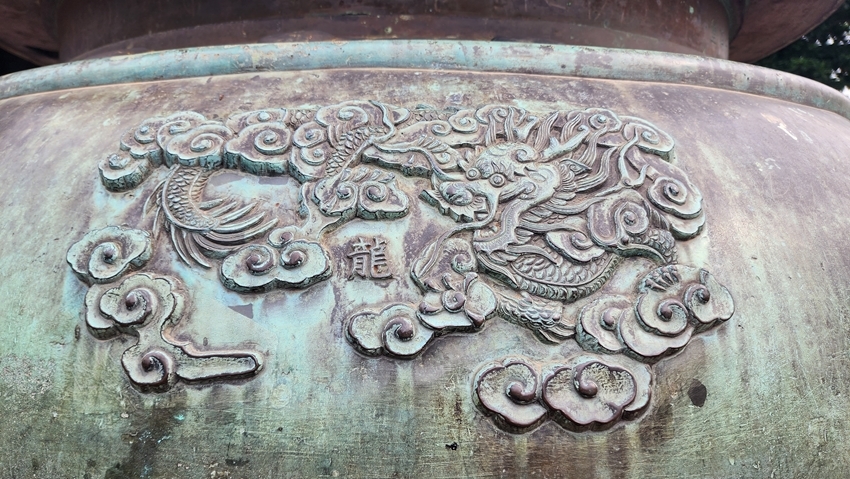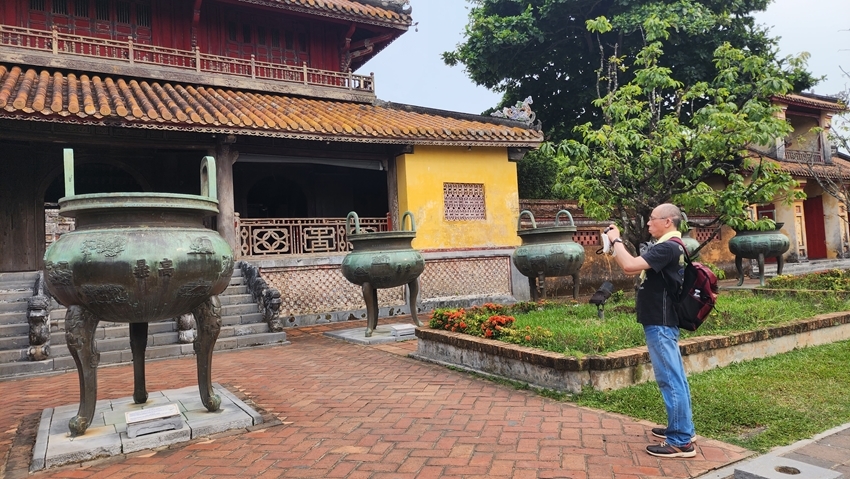 |
| The Nine Dynastic Urns of the Nguyen Dynasty were cast in 1835 by order of emperor Minh Mang, and is currently located in The To Temple. |
One of the important contents of this meeting is reviewing the dossiers submitted for registration of regional documentary heritage from many countries. Along with the representatives of the National Cultural Heritage Committee of Vietnam, representatives of Thua Thien Hue Province will attend the 2024 MOWCAP Conference to defend the dossier requesting UNESCO to register the Nine Dynastic Urns of the Nguyen Dynasty to become a World Memory Heritage.
According to Dr. Phan Thanh Hai, Director of Culture and Sport Department, in the Asia-Pacific region, there are altogether 20 dossiers in which Vietnam has one about the Nine Dynastic Urns of the Nguyen Dynasty. Very likely this will be the 10th World Memory Heritage from Vietnam and the 4th from Hue besides Woodblocks of the Nguyen Dynasty (2009), Imperial Archives of the Nguyen Dynasty (2014) and Literature on Hue Royal Architecture (2016).
Cuu Dinh is the Nine Dynastic Urns of the Nguyen Dynasty cast by order of emperor Minh Mang in 1835-1837 and located on the courtyard of The To Temple in Hue Imperial City. After nearly 200 years, the urns still come intact. They have never been repaired before, so they are the originals and also the only ones. The Nine Dynastic Urns were recognized as National Treasure in 2012.
 |
| Each embossed pattern on the urns is like an independent piece of sculpture rich in folklore. |
All the nine urns are very big in size with an average height of 2.3m and similar in shape: round body, tight neck, flared mouth, with two straps on each mouth, and three legs. On each neck is recorded on the right with the year in which it was cast (1835) and on the left with the weight ranging from 3,201- 4,307 Vietnamese pounds.
The Nine Dynastic Urns are embossed with symbolic patterns such as rivers and mountains, specialties from various parts of the country, plants and flowers and typical man-made objects reflecting in an original manner the Vietnamese outlook of life and the Vietnamese world view in the 19th century. They also prove the outstanding talent of bronze casting artisans of our country.
 |
| Tourists taking photos with the Nine Dynastic Urns in Hue Imperial City |
Besides being the symbols for the emperors and showing the power of the Nguyen Dynasty, the Nine Dynastic Urns are like a “geography book” of Vietnam in early 19th century with a total of 162 patterns which are exquisitely embossed.
According to Dr. Phan Thanh Hai, the Nine Dynastic Urns of the Nguyen Dynasty meet all the criteria of UNESCO for Documentary Heritage - Memory Heritage in terms of shape, style, social significance, gender equality, communal spirit, uniqueness, rarity, integrity, etc. It can be said that the Nine Dynastic Urns of the Nguyen Dynasty is the unique set of artifacts not only of Vietnam but also of the world. Therefore, the Dynastic Urns of the Nguyen Dynasty have been recognized as National Treasure by the Prime Minister in January 1st, 2012, and Thua Thien Hue Province is very confident when choosing this treasure to submit to the UNESCO World Memory Heritage Committee.
|
|
The World Memory Heritage (or the World Documentary Heritage) is one of the types of heritage that UNESCO honors. Currently, Vietnam boasts 9 UNESCO World Memory Heritages three of which are of world level: Woodblocks of the Nguyen Dynasty in Hue (2009), Doctoral Steles at the Temple of Literature in Hanoi (2010) and Imperial Archives of the Nguyen Dynasty in Hue (2017) and six of which are of Asia-Pacific level: Woodblocks at Vinh Nghiem Pagoda in Bac Giang (2012), Literature on Hue Royal Architecture (2016), School Woodblocks at Phuc Giang in Ha Tinh (2016), Hoang Hoa Su Trinh Đo (Envoy’s Journey to China) in Ha Tinh (2018), Sino-Vietnamese Demotic Documents at Truong Luu Village (2022) and Ma Nhai (Inscriptions) on the Marble Mountains in Danang (2022).
|